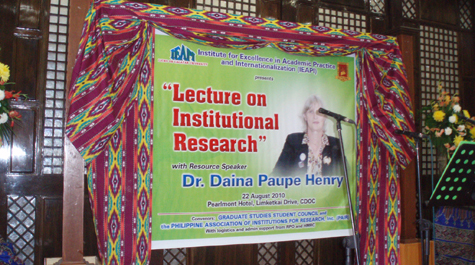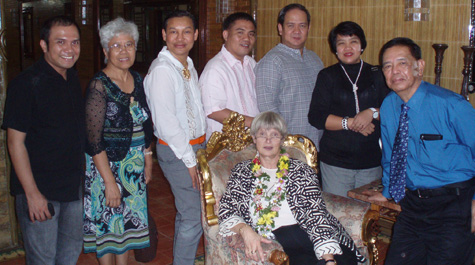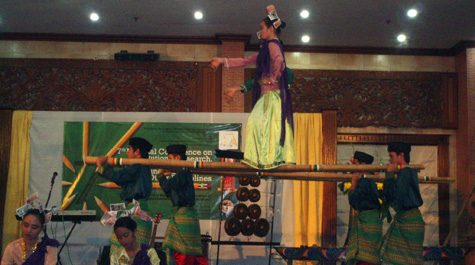Daina Henry's Philippines excursion: teach, but learn
For Daina Henry, it was this past summer in the Philippines.
Henry is William & Mary’s director of special projects, reporting to the Office of Institutional Analysis and Effectiveness and the Office of Enrollment, formerly Institutional Research. When asked once to describe what an institutional researcher does, she explained to her mother that she “counts things for a living.” That includes the students, faculty, books, buildings, salaries, financial aid, and so forth. The purpose for the analysis of information is to help the provost and the president make informed decisions.
“We are management information, accreditation, and assessment,” she explained.
Henry, who jokes that she has worked at William & Mary for so long that her colleagues swear she knew Thomas Jefferson, also serves on the Association for Institutional Research’s national board of directors as secretary and external relations chair. Her duties include outreach to international groups of institutional researchers who want to join the AIR to enhance their professional development and to share knowledge and skills.
That’s how she came to receive an invitation from the Philippine Association for Institutional Research to serve as keynote speaker at its August conference. A country of approximately 92 million people (in 2009), 2.4 million of them higher-education students (in 2004-2005), the Philippines has sought to develop a more international presence, in part to provide faculty members more outlets to present their research. The country has limited opportunities for faculty engaged in research to present and publish domestically.
“They needed someone to talk about institutional research, and we (AIR) have a great desire to do outreach,” Henry said. “William & Mary, with its push to become more global, more international, just further encouraged me. I thought it was the perfect opportunity on a number of different levels.”
Suffice it to say that Henry, considered by some to be an industry leader, interacted with hundreds of people during her brief time in the Philippines, shared the benefits of fitting together institutional research, business management, and higher education research gleaned from her almost 30 years in the profession. The experience allowed Henry to form many mutually beneficial lifelong connections and she continues to keep the collaboration alive, engaging her new colleagues in a current international research faculty survey being coordinated by William & Mary’s School of Education.
What’s more interesting, she would admit, is that she returned to the United States “a changed person, certainly having learned as much from them as I left behind.”
“One of the main things I took away was how culturally based education is,” she said.
Take the financing of a college education. Henry’s research revealed that out of the 2.4 million college students, only 17,000 received financial assistance from the federal government, a figure that included loans.
“How do they pay for it? They start saving from the day they are born,” Henry said. “The American model is we’re going to pursue higher education and we’re going to take out a loan to pay for it, if need be. Their view is, ‘No, you save from the day you are born to afford it.’ It was not uncommon for brothers and sisters, aunts and uncles to contribute so that siblings and relatives could go to college.”
Then there was the intense pride students had in their schools. Students there had watched enough American television to see college students dressed in ways that befuddled them.
“They didn’t understand why anyone from William & Mary would wear a UVA T-shirt,” she recalled. “They even said, ‘Not a single student would ever dare wear anything but their own school’s logo.’ I’m not saying that William & Mary people don’t have that intense pride, too, but I guess we show it in different, maybe not so overt, ways.”
Every seminar and every speech Henry gave began the same way, with the playing of the Philippine national anthem, the singing of the host school’s song, and a cultural performance by singers or dancers who were students at the higher education institution sponsoring the talks.
One day, nearly 30 schools brought performers with them. It was explained to Henry that, “these are (their equivalent of our scholar-athletes).”
“They have sports programs. They just don’t subsidize them with scholarships,” she said. “Instead, they host national competitions encouraging cultural singing and dancing, with performances of indigenous dance, modern dance, native and modern songs. The Philippines’ is a nation of 7,000 islands, many with their own dance, dialect, and song. That’s a lot of competition.
“Now, imagine telling any athletic director that their scholarship money wasn’t going to athletes, but to the dance team and the chorus. You talk about a totally different way of thinking.”
Unlike the U.S., many of the institutions have open admission, but selective retention policy.
“You start with large class sizes and trim down,” Henry said. “The traditional path is similar to high school block scheduling. Everyone has a certain set of classes; only non-traditional students – those who have failed – are allowed to choose the courses they take.
“It’s totally different, but you can understand it. They’re an emerging country. They need professionals, need lawyers, engineers, doctors, nurses.
“Their culture is driving their curriculum. They need professionals. So they have structured their curriculum so that for the most part, graduate programs are only offered in the evening or on weekends. This allows the graduate to work while they pursue post baccalaureate education. It was really enlightening to see how different they were in terms of understanding education. I think they felt a little bit of joy in my saying it was OK to be different; don’t be the American model. We could help them but we’re not necessarily the only way of doing things.”
Even the way they handle travel reimbursements was radically different. Henry spent lots of time posing for pictures with conference attendees. Why?
“In order to be reimbursed for travel you had to have a photo of yourself with one of the speakers to prove that you were there,” she explained. “It was mandatory and part of their auditing procedures.”
Henry said that as time went on, she began to feel more like a “conduit” than a lecturer. There is a lot of great research going on in the Philippines, but those doing it have almost no way of presenting it to audiences outside of their individual schools. She was inundated with questions from professors about where they should go to get their work exposed, or who to contact to start international collaboration.
“They’re doing research under incredibly difficult conditions,” she said. “Just as in the U.S., faculty members have to publish articles and present findings, yet they don’t know how to take the next steps, or how to get the limited opportunities. I didn’t either, but by my being there and my encouraging them to become members of AIR (or other academic organizations) hopefully will open the door to them making the right connections.
“I came away from the Philippines thinking, ‘Let’s get people talking, because there’s nothing wrong with international cooperation once you understand the cultural differences.’ ”
 Skip to main content
Skip to main content



